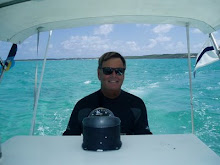Mission of the ACCSR program in The Bahamas:
(1) survey the archipelago for foraging and nesting populations of sea turtles
(2) establish long-term demographic studies of sea turtles
(3) use a variety of tagging and molecular techniques to answer the questions: where do turtles in The Bahamas come from, how long do they stay, and where do they go when they leave The Bahamas?
SURVEYS:
We make GPS track surveys of turtle feeding habitats throughout the Bahamas to assess populations. Repeated surveys help us establish long-term demographic data.
(chart used with permission of Lewis Offshore Ltd)
TAG AND RECAPTURE DATA:
Over the past 30 years the ACCSR and Stephen Connett have tagged thousands of sea turtles in their feeding habitats in the Bahamas. Hundreds of these turtles have been recaptured locally and throughout the Caribbean region. Bjorndal and Bolten have published much of these data and the results of their research in Great Inagua. Go to the ACCSR website (http://accstr.ufl.edu/) and click on “Conservation Strategy for Sea Turtles in the Bahamas” to download publications.
 arrows indicate green turtle migrations from Great Inagua
arrows indicate green turtle migrations from Great Inagua
TAG AND RECAPTURE DATA:
Over the past 30 years the ACCSR and Stephen Connett have tagged thousands of sea turtles in their feeding habitats in the Bahamas. Hundreds of these turtles have been recaptured locally and throughout the Caribbean region. Bjorndal and Bolten have published much of these data and the results of their research in Great Inagua. Go to the ACCSR website (http://accstr.ufl.edu/) and click on “Conservation Strategy for Sea Turtles in the Bahamas” to download publications.
 arrows indicate green turtle migrations from Great Inagua
arrows indicate green turtle migrations from Great InaguaDNA ANALYSIS:
Over the years turtle biologists have taken blood and tissue samples from thousands of turtles in the north and south Atlantic. Mitochondria DNA analysis and tag and recapture studies have shown that female turtles nesting on the same beaches can be identified as distinct DNA groups. Scientists have also proven that a very high percentage of nesting females return to their natal beaches to nest.
Analysis of DNA samples taken from Union Creek in Great Inagua have shown that the majority of turtles feeding in Union Creek were born in the Caribbean, Florida, and South America.
Over the years turtle biologists have taken blood and tissue samples from thousands of turtles in the north and south Atlantic. Mitochondria DNA analysis and tag and recapture studies have shown that female turtles nesting on the same beaches can be identified as distinct DNA groups. Scientists have also proven that a very high percentage of nesting females return to their natal beaches to nest.
Analysis of DNA samples taken from Union Creek in Great Inagua have shown that the majority of turtles feeding in Union Creek were born in the Caribbean, Florida, and South America.



No comments:
Post a Comment